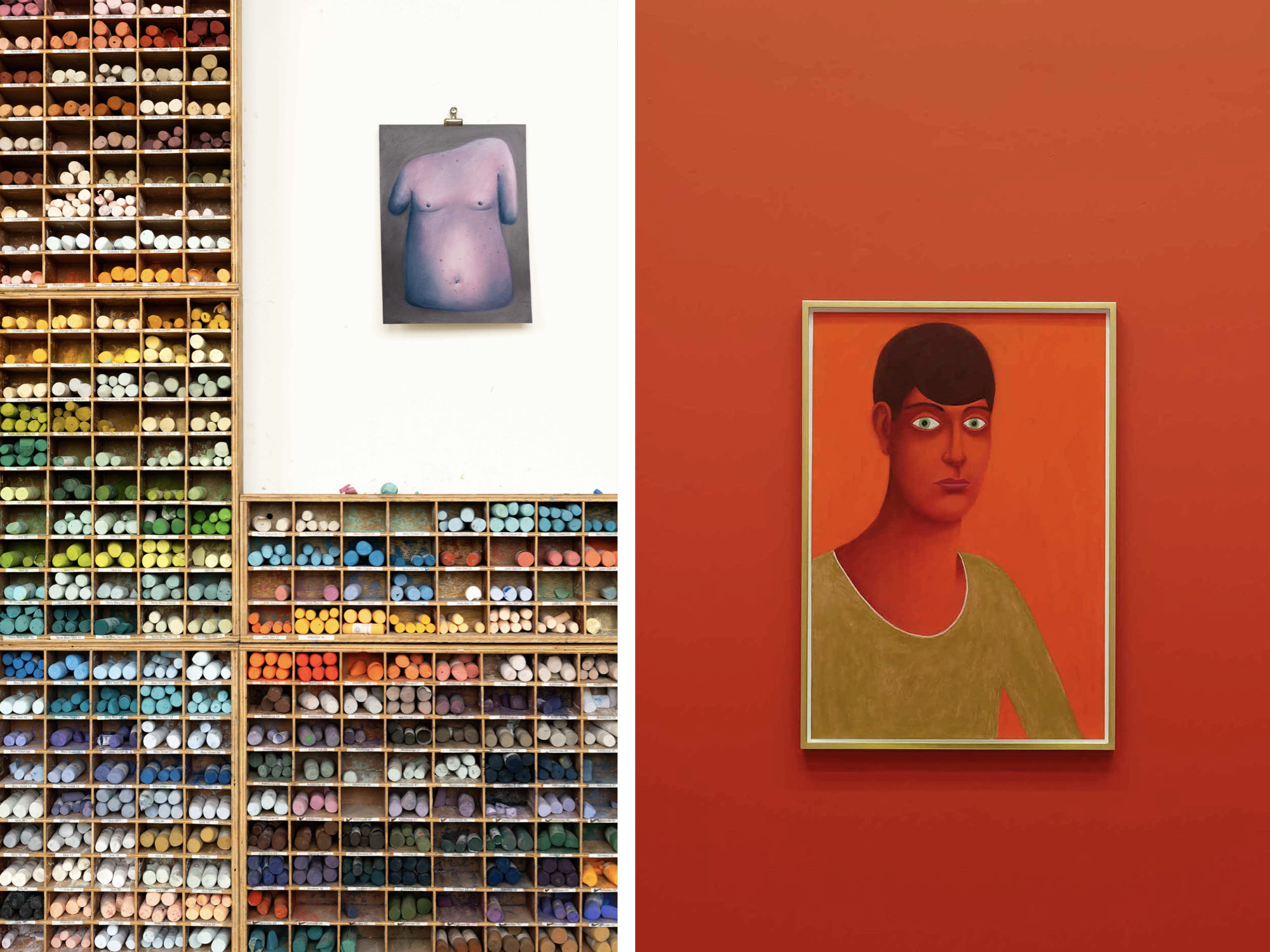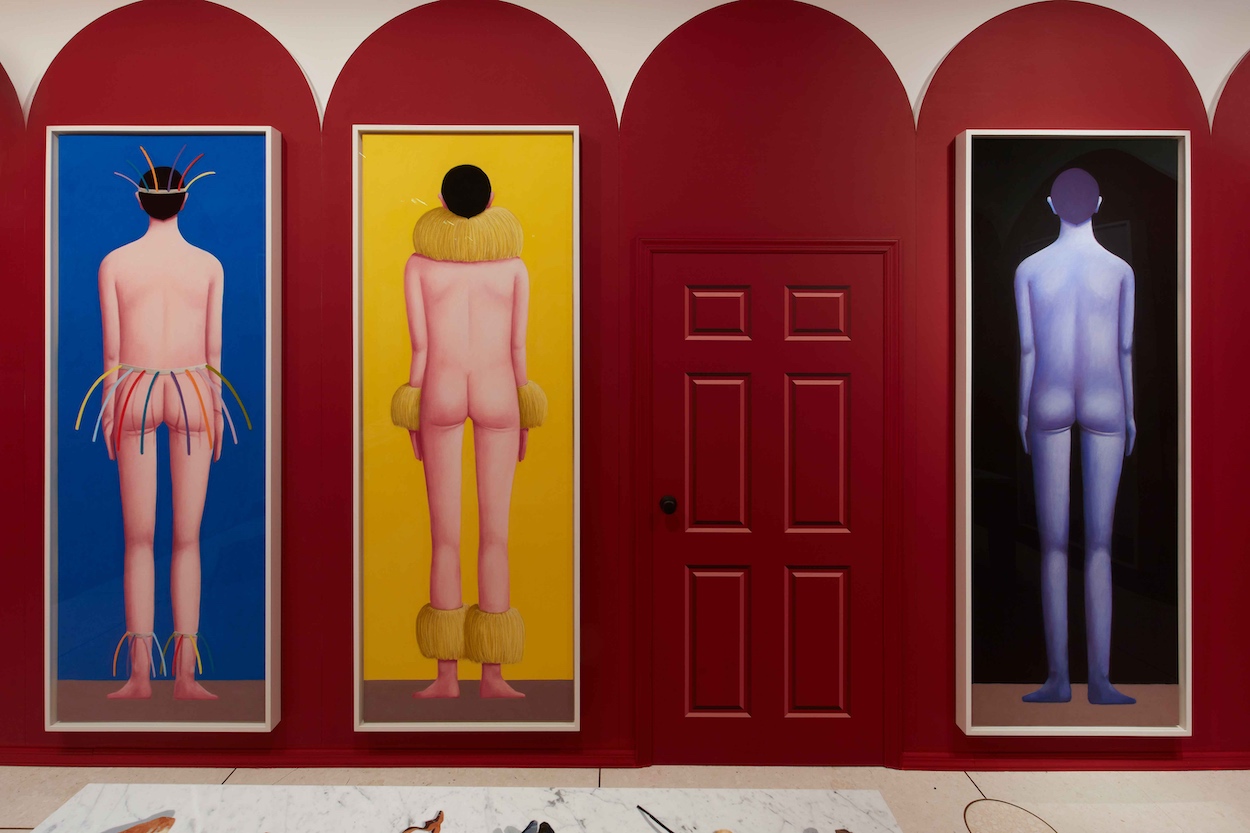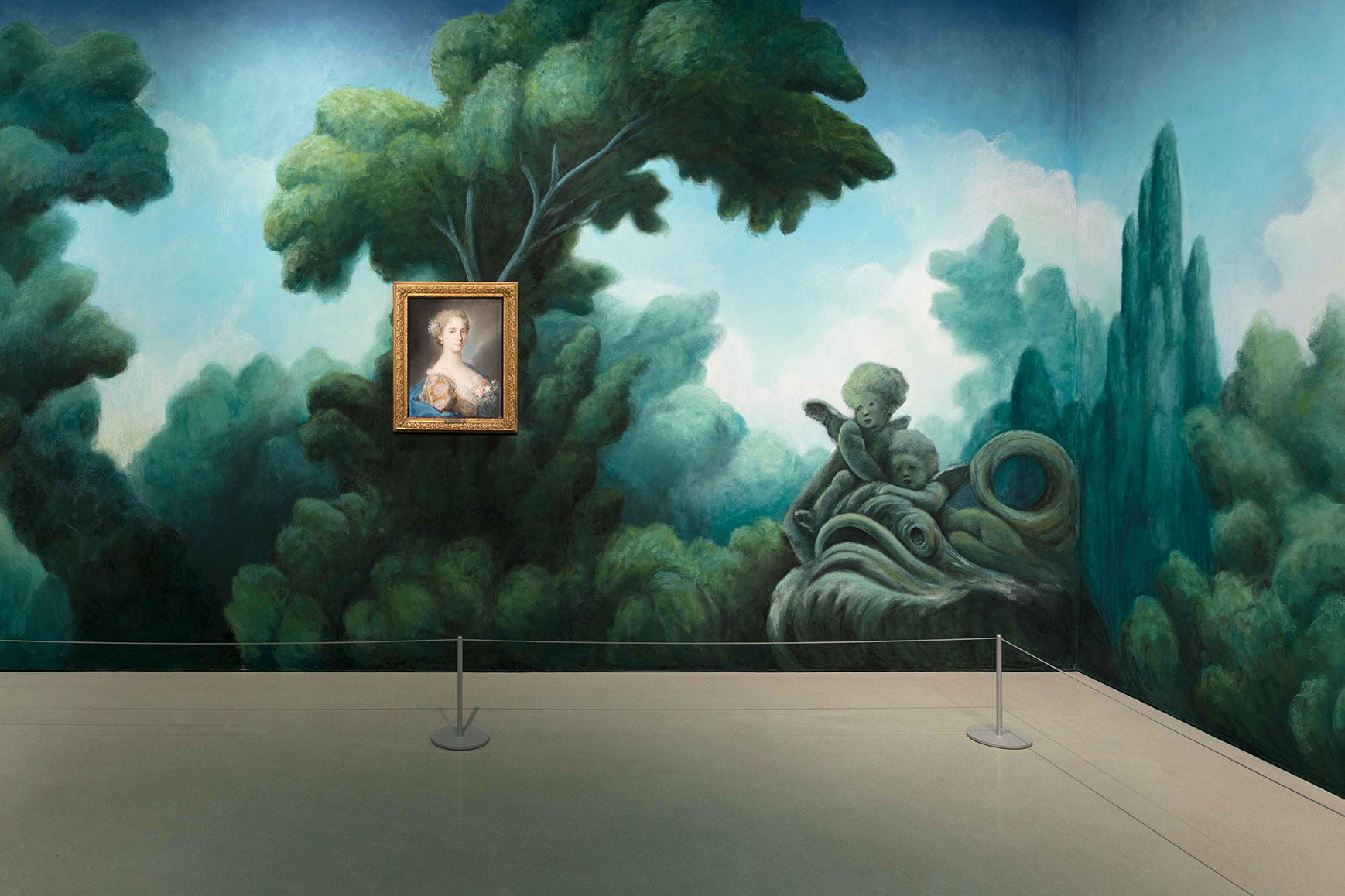December 4, 2019
Download as PDF
View on Surface Magazine
With his radically modern pastel works and flair for the uncanny, the Swiss artist has grabbed the attention of the art world.
 Nicolas Party, Head, 2019; other works in progress at the artist’s studio.
Nicolas Party, Head, 2019; other works in progress at the artist’s studio.
There’s a steady hum of activity in the Brooklyn studio of Nicolas Party. It’s a brisk October afternoon and the artist and his team, just back from lunch, are busily wrapping and moving artwork from one of the open areas to a storage room. “My girlfriend and I are in-between apartments so I brought some of my artwork from home to keep here,” he says. Adding to the activity, he explains, is the fact that in two days, he needs to be on a plane to Brussels—where he used to live and where he still keeps a house—for an exhibition of his new work at Xavier Hufkens, running through mid-December. Suddenly, there’s the loud thump of moving furniture and the whirrr of an electric saw. Construction workers have arrived to finish their renovation of Party’s office area, in the back portion of the studio. Today, they’re focused on the custom wood shelving and painting the walls a gorgeous cameo pink. “You like the color?” asks Party with a smile. He appears not the least rattled by the fact that he’s moving apartments, getting ready for a trip, planning two major exhibitions, having his office space turned inside out, and being interviewed for a magazine, all at the same time. “I love pink walls!” he says.
If you’re someone who closely follows contemporary art, you’ve probably heard the name Nicolas Party amping up in volume with each passing season. This is particularly the case in New York, where the 39-year-old Swiss artist—who creates paintings, drawings, sculptures, and conceptual installations and has almost single-handedly spurred a newfound appreciation for work made with pastel—moved about three years ago. He’s the artist behind Dinner for 24 Sheep, the 2017 performance piece-cum-installation at the Metropolitan Opera’s Gallery Met that had art-world insiders like John Currin and Elizabeth Peyton locked in a room for a four-hour dinner. Party’s intensely hued works, which feature impassive blue, orange, and green faces, biomorphic teapots, and unearthly trees and mountains, have been the subject of solo shows in Beijing, Brussels, and Glasgow, as well as the Hirshhorn Museum in Washington, D.C. This past fall, Party put together one of New York’s most joyfully immersive and—it must be said—Instagram-friendly exhibitions in recent memory, a show of large-scale pastel wall murals juxtaposed with smaller pastel works from 18th-century and contemporary masters at Chelsea’s Flag Art Foundation through mid-February. In the past year, he also threw another FOMO-inducing happening in Newport, Rhode Island, where New York’s art insiders were treated to a surrealist night of sculpture, choreographed dinner service, and guerilla theater. And oh, yeah, the biggest news of all: Hauser & Wirth added Party to its powerhouse roster and announced his first show with the gallery, in February 2020, at its Los Angeles outpost.
 (From left) Nicolas Party’s studio detail; Nicolas Party holding Torso, 2019; (behind) Landscape, 2018 (Photographs by Juliana Sohn)
(From left) Nicolas Party’s studio detail; Nicolas Party holding Torso, 2019; (behind) Landscape, 2018 (Photographs by Juliana Sohn)
So yes, things are looking quite rosy in Party’s world, the pink walls in his studio, aside. One consistent feature of the artist’s exhibitions are the intensely hued wall colors he chooses to complement his paintings. Sometimes they are periwinkle, or teal, or goldenrod yellow, or, pink. (According to Flag Art director Stephanie Roach, the foundation needed more than 30 gallons of paint, including Benjamin Moore’s Passion Pink, to prepare the walls.) He complements the walls by building de Chirico-esque narrow rounded archways between the rooms, which let viewers experience a sense of traveling through space and time as they go from room to room. (For Grotto, his show at Xavier Hufkens, he built three such archways.) He considers these “architectural interventions,” as he calls them, integral to his practice: “I like to create the exhibition as a complete environment.”
“Nicolas has this overarching vision,” says Karma gallery founder Brendan Dugan, one of Party’s earliest New York friends and supporters. “His incredible energy seeps into everything, from his artmaking to his installations, his curating, his performances, and his day-to-day life. There’s so much excitement, energy, and beauty that goes into everything he does.”
In fact, as anyone who meets Party instantly fathoms, he is a man with an unapologetic zeal for beauty. He sports a trim beard and dresses with Euro-sporty élan (think: Lacoste, Missoni) and takes obvious delight in surrounding himself with good things. Not for him a ramshackle studio with milk crates and Ikea furniture. A seating area in his studio includes a handsome vintage leather sofa and a marble-inlay table (which he designed himself). In his office, he’s installed a colossal Noguchi ceiling lantern (a hand-me-down from a friend, who found it too big for his own home). Even the bathroom, which he recently renovated with gorgeous blue-green tiles, has a certain flair. “We spend a lot of time in the studio, so I want it to be really nice,” he says, shrugging.
 (From left) A view of Party’s dedicated pastel room in his studio; pastel on paper in progress. Installation view of Red Portait, 2017 in “Pastel” at Karma, New York, 2017.
(From left) A view of Party’s dedicated pastel room in his studio; pastel on paper in progress. Installation view of Red Portait, 2017 in “Pastel” at Karma, New York, 2017.
Party grew up in Lausanne, Switzerland, where his father worked as an accountant and his mother ran a museum book- shop. He began painting at age 12, mostly mountain landscapes of the natural beauty surrounding him. But as he grew into adolescence, he became a dedicated graffiti artist, idolizing street artists like Dare, who was based in Basel, Switzerland, and became an international star in the ’90s. “From age 12 to 21, the whole street art thing is what I loved,” Party says. “My friends and I would travel all around, we did graffiti in France, Spain, Germany, Italy—I was caught once in Italy. And one time I painted a train,” he says with a grin. “I mean, it’s obviously the funnest thing to do.”
He switched gears from spray cans to oil paints when he moved to Scotland to get his masters at the Glasgow School of Art. “The funny thing is that graffiti actually has a very closed mindset,” he says. “You have to do things according to the graffiti rules.” In Glasgow, where he lived for several years after graduation, Party further developed his classical painting techniques and also began experimenting with different forms of installation and performance-based art. In 2011, he received his first major attention with a performative event he staged at Glasgow’s Modern Institute. He invited two dozen guests, a mix of curators, gallerists, and collectors, to a dinner at the gallery for which he had designed everything—from the plates and tables to the seats and food. The guests sat on stools painted with elephants while Party and two gallery directors assumed the role of waiters. The evening, which Party dubbed Dinner for 24 Elephants, was the first iteration of his ongoing series of dinner party happenings.

Installation view of Party’s Dinner for 24 Sheep at the Metropolitan Opera, New York, 2019.
Three years later, Party made his biggest breakthrough when he came across Picasso’s Tête de femme, a pastel made in 1921 during the master’s neoclassical period. “I was like, Oh my god, this is exactly what I want to do,” he recalls. He saw how the medium allowed Picasso to convey shading, shadows, and volume, and he was struck by the way the artist rendered his subject’s face with the stolidity and androgyny of classic Greek sculpture. “I went to the art store the next day and bought a box of pastels,” he says. The material has become his signature ever since.
Pastels, he explains, have been unjustly dismissed over the past couple of centuries as a “hobby medium,” or at the very best, something an artist will use for a preparatory sketch. But in Party’s hands, the pastels are used to create lush, velvety images of great intensity and impact. Party’s work is most often compared to that of artists like René Magritte, Giorgio Morandi, and Henri Rousseau, but in his pastels’ bold lines you can also trace a line of influence back to Party’s graffiti art days, he points out. “The super-bright colors, the very clear lines and effective shapes, these are all things you do with graffiti,” he says.
 Installation view of Nicolas Party: Pastel at The FLAG Art Foundation, 2019.
Installation view of Nicolas Party: Pastel at The FLAG Art Foundation, 2019.
“He’s brought pastel, a medium with hundreds of years of history, back to the forefront and made it contemporary and fresh,” says Flag Art’s Stephanie Roach. Collectors certainly seem to agree: Earlier this year, one of his pastel landscapes sold at auction for $608,000 and one of his pastel portraits went for $726,195, setting Party’s current record.
The recent financial success is something he doesn’t take lightly. “There are so many great artists out there, and not everybody has this kind of luck,” he says. “I think that the decade from about 35 to 45 is when you have to push as much as you can. If you’re lucky enough to have all those people asking for things, you have to do it. You never know what’s going to happen.” At the same time, he has no qualms about enjoying the pleasures his success has brought him, whether that includes zhuzzing up his studio or building his own art collection. In recent months, he’s bought works by Matthew Wong, Lucy McKenzie, Ann Craven, and George Grosz. And now he has his eye on a canvas by 17th-century Dutch master Otto Marseus van Schrieck, who painted elegantly menacing snakes and frogs. “Look at this amazing one coming up for auction,” he says, pointing to his laptop. “He’s my new obsession.”
He pauses for a moment. “I was talking to Brian Donnelly— Kaws—the other day and he said that he’s always suspicious of artists who find success and don’t buy art,” he added. “I totally agree. You have to spend it.”



